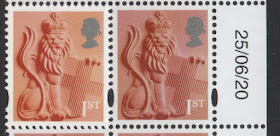Another announcement from Royal Mail
Royal Mail has had to make changes to some of its International rates having experienced significant rising air freight costs due to passenger planes being grounded to limit the movement of people between countries to contain COVID19. The new 1st September tariff is necessary in order to meet the costs we have absorbed to date.
There are no new Definitive or Country Definitive stamps issued at the new values. Post Office branches will make up the value of the postage with a range of stamp values.
Tariff wef 01/09/2020
|
Europe
|
Worldwide1
|
Worldwide2
|
Up to 10g
|
£1.45 (1.42)
|
£1.45 (1.42)
|
£1.45 (1.42)
|
Up to 20g
|
£1.45 (1.42)
|
£1.70 (1.63)
|
£1.70 (1.63)
|
21g to 100g
|
£1.70 (1.68)
|
£2.50 (2.42)
|
£2.55 (2.42)
|
Note that this means that the Worldwide up to 20g rate is now the same as the Europe 100g rate, and that the rate to Singapore, Australia and the Pacific Islands now has a higher rate than the rest of the world.
UPDATE later same day:
I'm repeating John H's comment here
All the details of the new prices (including PDFS of the various price regimes) can be found on the page at https://www.royalmail.com/prices2020. Regarding the table above, Worldwide3 (USA) has the same prices as Worldwide1 (this isn't true for Large Letters or Printed Packets, where all 3 zones have different prices).
Zone 3 was introduced on 1 July with almost no notice, so at least this is an improvement. The increases have a knock-on effect on all premium services with differentials now on Large Letters as well as Small Parcels. (Click on image to see larger versions)
 |
| New airmail postage rates from 1 July (left) and 1 September (right) |
Effect on current stocks
For 2019 we know of printings for the basic make-up stamps as follows:
1p x 3
2p x 2
5p x 4
10p x3
So far this year we have single printings for the 2p and 10p - with these new rates requiring the addition of many make-up stamps, I think we can expect more printings soon, especially for the 1p & 5p.
£1.45 needs 1p + 2p
£1.70 needs 5p + 2p, or just 2p
£2.50 needs 5p + 2p + 1p
£2.55 needs 10p + 2p + 1p
The Rupert Bear stamp issue will be the first to include any of the new rates.
UPDATE 7 August.
I overlooked the Large Letter rate stamps which were issued in March.
As well as the basic letter rates mentioned above, the following stamps will also need supplementary stamps to make the new rates:
£2.97 +1p+2p = £3.00*
£3.66 + 2p+2p+5p = £3.75
£3.82 + 1p+2p+20p+20p = £4.25
* There is, of course, a £3 stamp though not generally available at Post Office Branches. This may be brought back into general use. It has been printed only in 2009 and 2019, but if large users buy these or Post Offices want to use them instead of multiple stamps, we may see a reprint in 2020.



































